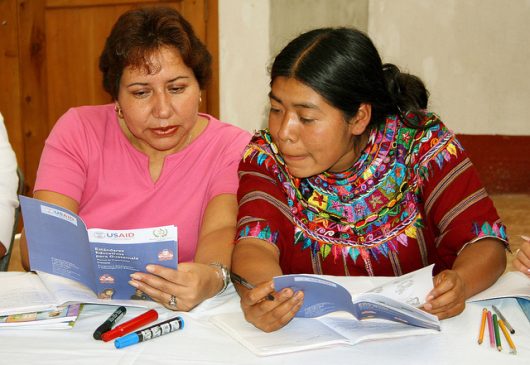Girls’ Education in Guatemala Becoming More Accessible in Rural Areas

Attending school in Guatemala presents many challenges. In a country where poverty and inequality are prevalent, indigenous females are the most disadvantaged and vulnerable group. With little protection of the rights of adolescent girls, many girls and women do not attend school and are forced into child labor. More than two million children in Guatemala are not attending school; the majority of these are indigenous girls living in rural areas.
Barriers to Education in Guatemala Affect Girls Most
The prevalence of child labor is higher in Guatemala than anywhere else in Latin America. With more than half the population living below the poverty line, many children can not afford the cost of school. Dropout rates for girls are high. According to the Cooperative for Education, a nonprofit organization providing educational resources and opportunities to indigenous Mayan schoolchildren, an indigenous Guatemalan woman stays in school for an average of 1.8 years. They often leave school early to help support their family, take care of siblings or get married.
Furthermore, more than half of the Guatemalan population is indigenous and less than 30 percent of poor, rural indigenous girls are enrolled in secondary education. By age 17, only 26 percent of indigenous girls are still enrolled in school.
Even for those who are able to attend school, particularly in rural schools and in indigenous communities, they find that they are poorly funded and do not have adequate books, curriculum guides, literacy materials and exam prep guides. Nine out of 10 schools in rural Guatemala lack books. Another problem, especially in rural areas, is a lack of proper training for teachers. This stems from the challenges of recruiting and retaining quality teachers in rural schools.
USAID Partners with Guatemalan Ministry of Education
Despite these challenges, there are actions being taken by organizations to improve the quality of education. USAID works in partnership with the government of Guatemala to improve primary level reading skills and provide educational opportunities for out-of-school youth. These efforts have resulted in improvements to the education system in many ways, as the Ministry of Education has now developed strong K-9 national education standards.
USAID has also implemented an innovative assessment system for entry-level teachers using standardized testing in Spanish and nine Mayan languages to hire and place teachers. It was also through USAID support that the ministry improved its transparency and efficiency of its processes, which led to it receiving an international certification of its management system. The ministry is the first public institution to meet this standard.
Girl Up Gives Special Focus to Girls’ Education in Guatemala
The need for investment in girls’ education in Guatemala is crucial. Education can help fight the disadvantages indigenous girls in Guatemala face, such as limited schooling, early marriage, frequent childbearing and chronic poverty. Work supporting girls’ education in Guatemala is progressing. Girl Up supports adolescent girls in Guatemala by funding a United Nations joint program which delivers an integrated and comprehensive package of services in partnership with national partners and local implementing organizations. The programs address complex challenges which limit indigenous girls’ opportunities for success.
Girl Up has four strategic goals, including:
- Providing an increase in social investments for adolescent girls
- Increasing the legal age of marriage to 18
- Reducing teenage pregnancy, sexual violence and trafficking
- Supporting civil efforts that demand comprehensive sex education
It also works to strengthen government support and capacity with a specific focus on indigenous girls in rural areas with Guatemala’s Ministry of Education, Ministry of Health and the National Institute of Statistics to support adolescent girls from around the country.
Building partnerships with local organizations is also a focus of Girl Up. Through this, it has implemented activities that have strengthened the social skills of hundreds of adolescent girls from rural communities. Girl Up supports U.N. programs in two of the most excluded and vulnerable regions of Guatemala, Totonicapán and Huehuetenango. This support has included providing educational materials in indigenous languages to make learning easier and giving girls forced to drop out of school a second chance.
Through these investments in girls’ education in Guatemala, lives will be changed. Girls will have the ability to achieve their goals, improve their futures and change their communities.
– Ashley Quigley
Photo: Flickr
